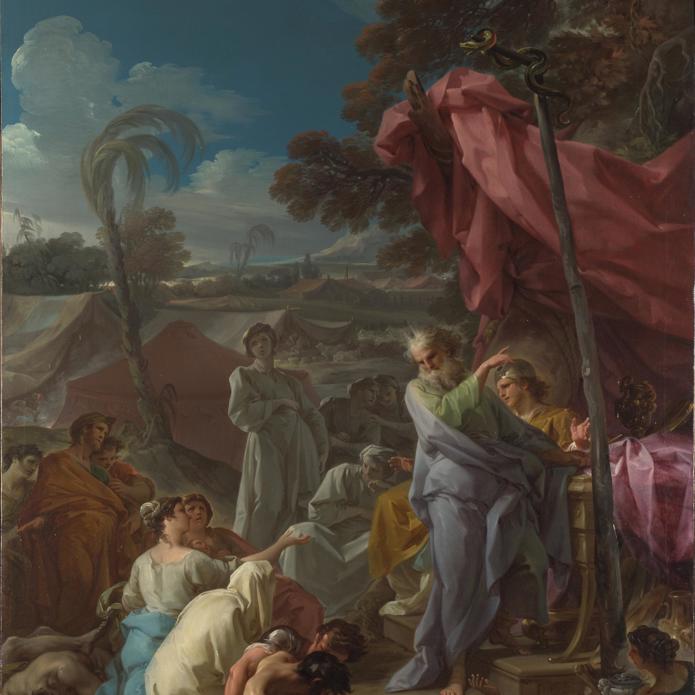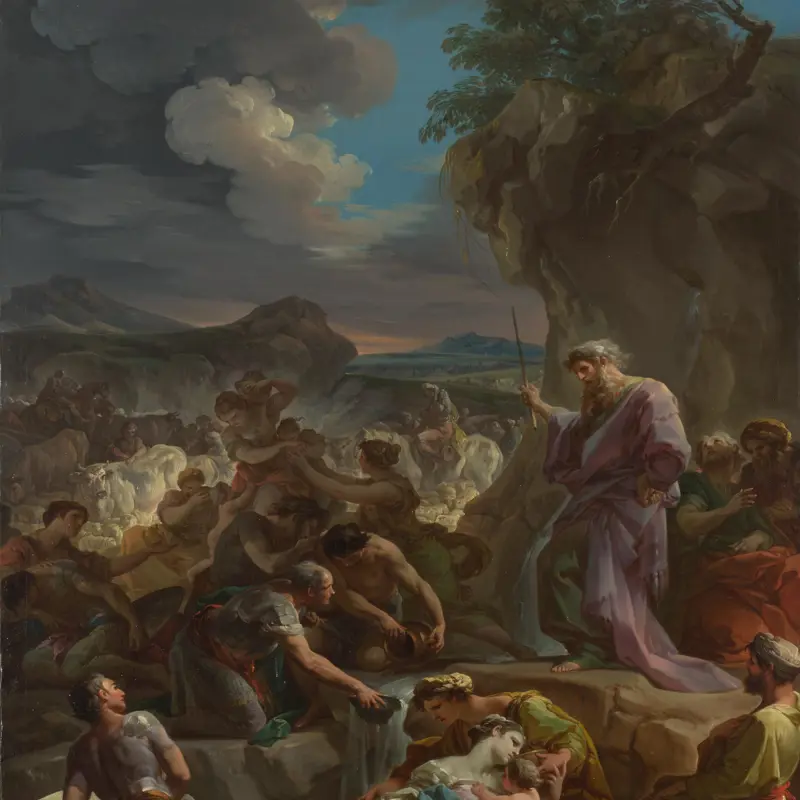Corrado Giaquinto, 'Moses striking the Rock', 1743-4
About the work
Overview
According to the Old Testament Book of Exodus, the Israelites and their flock were thirsty after failing to find water during their long journey through Egypt. God instructed Moses to stand in front of the people with the elders of Israel and strike the rock of Horeb with his staff. A fresh stream of water gushed from the rock, enabling the Israelites and their animals to quench their thirst. Giaquinto shows the elderly Moses brandishing the miraculous staff. The delicate hues of his draperies harmonise with those of the figures in the foreground and contrast with the dull colour of the rocky landscape.
This is a modello, or highly finished painted study, for a fresco in the apse of the basilica of Santa Croce in Gerusalemme, Rome. As with the related Brazen Serpent, also in the National Gallery, the dimensions are slightly larger than is usual for an oil sketch. This is probably so that the design could be approved by the Pope and the procurator of the Cistercian Order, Raimondo Besozzi, before its enlargement in fresco.
Key facts
Details
- Full title
- Moses striking the Rock
- Artist
- Corrado Giaquinto
- Artist dates
- 1703 - 1766
- Part of the series
- Modelli for Frescoes in S. Croce in Gerusalemme, Rome
- Date made
- 1743-4
- Medium and support
- oil on canvas
- Dimensions
- 136.5 × 95 cm
- Acquisition credit
- Bought, 1987
- Inventory number
- NG6516
- Location
- Not on display
- Collection
- Main Collection
- Frame
- 18th-century Italian Frame
Provenance
Additional information
This painting is included in a list of works with incomplete provenance from 1933–1945; for more information see Whereabouts of paintings 1933–1945.
Text extracted from the National Gallery’s Annual Report, ‘The National Gallery Report: January 1985 – December 1987’.
Bibliography
-
1988National Gallery, The National Gallery Report: January 1985 - December 1987, London 1988
-
2001
C. Baker and T. Henry, The National Gallery: Complete Illustrated Catalogue, London 2001
About this record
If you know more about this work or have spotted an error, please contact us. Please note that exhibition histories are listed from 2009 onwards. Bibliographies may not be complete; more comprehensive information is available in the National Gallery Library.
Images
About the series: Modelli for Frescoes in S. Croce in Gerusalemme, Rome

Overview
These two paintings are modelli, or presentation pieces, for frescoes in the basilica of Santa Croce in Gerusalemme in Rome. As part of the restoration of the church, which began in 1741, Giaquinto painted canvases for the nave’s ceiling and frescoes for the lower walls of the apse. In preparation for the commission, Giaquinto first painted bozzetti, or sketches, and then modelli for approval by the Pope and the procurator of the Cistercian Order, Raimondo Besozzi. The National Gallery has two of these modelli, featuring scenes of Moses’ miracles on his way to the Promised Land. The modelli enable us to reimagine the original colour scheme of the frescoes, which have been damaged by humidity and unsuccessful nineteenth-century restorations.
The relic of the True Cross brought back from the Holy Land by Helen, mother of the first Christian Roman Emperor (Constantine), provided the central subject of the church’s decorative scheme. The basilica had been built on the site of Helen’s villa, where the relics were originally housed.



